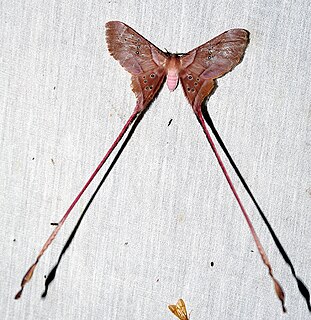
Lepidoptera is an order of insects that includes butterflies and moths. About 180,000 species of the Lepidoptera are described, in 126 families and 46 superfamilies, 10 percent of the total described species of living organisms. It is one of the most widespread and widely recognizable insect orders in the world. The Lepidoptera show many variations of the basic body structure that have evolved to gain advantages in lifestyle and distribution. Recent estimates suggest the order may have more species than earlier thought, and is among the four most speciose orders, along with the Hymenoptera, Diptera, and Coleoptera.

Moths are a paraphyletic group of insects that includes all members of the order Lepidoptera that are not butterflies, with moths making up the vast majority of the order. There are thought to be approximately 160,000 species of moth, many of which have yet to be described. Most species of moth are nocturnal, but there are also crepuscular and diurnal species.

The de Havilland DH.82 Tiger Moth is a 1930s British biplane designed by Geoffrey de Havilland and built by the de Havilland Aircraft Company. It was operated by the Royal Air Force (RAF) and other operators as a primary trainer aircraft. In addition to the type's principal use for ab initio training, the Second World War had RAF Tiger Moths operating in other capacities, including maritime surveillance and defensive anti-invasion preparations; some aircraft were even outfitted to function as armed light bombers.

Martin Elias Peter Seligman is an American psychologist, educator, and author of self-help books. Seligman is a strong promoter within the scientific community of his theories of positive psychology and of well-being. His theory of learned helplessness is popular among scientific and clinical psychologists. A Review of General Psychology survey, published in 2002, ranked Seligman as the 31st most cited psychologist of the 20th century.

Saturniidae, commonly known as saturniids, is a family of Lepidoptera with an estimated 2,300 described species. The family contains some of the largest species of moths in the world. Notable members include the emperor moths, royal moths, and giant silk moths.

Saturnia pyri, the giant peacock moth, great peacock moth, giant emperor moth or Viennese emperor, is a Saturniid moth which is native to Europe. The species was first described by Michael Denis and Ignaz Schiffermüller in 1775. It is the largest European moth, with a wingspan reaching 15–20 cm (6–8 in).

Actias is a genus of Saturniid moths, which contains the Asian-American moon moths. Long tails on their hindwings are among their distinctive traits. Other moths with similar appearance are Copiopteryx, Argema and Eudaemonia.

Cerura vinula, the puss moth, is a lepidopteran from the family Notodontidae. The species was first described by Carl Linnaeus in his 1758 10th edition of Systema Naturae.

The Saturniinae or saturniines are a subfamily of the family Saturniidae. They are commonly known as emperor moths or wild silk moths. They are easily spotted by the eyespots on the upper surface of their wings. Some exhibit realistic eye-like markings, whilst others have adapted the eyespots to form crescent moon or angular shapes or have lost their wing scales to create transparent windows. They are medium to very large moths, with adult wingspans ranging from 7.5 to 15 cm, in some cases even more. They consist of some of the largest sized Lepidoptera, such as the luna moth, atlas moth, and many more. The Saturniinae is an important source of wild silk and human food in many different cultures.
Energia or Energiya may refer to:

Eudaemonia is a genus of moths in the family Saturniidae. They are native to Sub-Saharan Africa and have remarkable, extremely elongated "tails" on the hindwings.

Lantanophaga pusillidactyla, the lantana plume moth, is a moth of the family Pterophoridae. It is native to the southern United States, Mexico, the Caribbean, and South America. It was introduced to Australia accidentally in 1936 and is now found from Sydney to Cairns along the coast. It has also been introduced to Hawaii in 1902, Pohnpei in 1948, and Palau in 1960 for biological control. It has since been recorded from Yap in 1987–1988 and is now distributed on all islands of the Mariana and Caroline Islands where the host plant is found, except Aguijan.

The Erebidae are a family of moths in the superfamily Noctuoidea. The family is among the largest families of moths by species count and contains a wide variety of well-known macromoth groups. The family includes the underwings (Catocala); litter moths (Herminiinae); tiger, lichen, and wasp moths (Arctiinae); tussock moths (Lymantriinae), including the arctic woolly bear moth ; piercing moths ; micronoctuoid moths (Micronoctuini); snout moths (Hypeninae); and zales, though many of these common names can also refer to moths outside the Erebidae. Some of the erebid moths are called owlets.

Eudaemonia argus is a species of moth in the family Saturniidae. It is found in Africa, in such areas as Gabon, Nigeria, Ivory Coast, Togo, Guinea and Benin. Adults have wings with shades of pinkish to brownish, with several small eyespots on the hindwings; the males have much longer and thinner "tails" on the hindwings than the females.
Eudaemonia argiphontes is a species of moth in the family Saturniidae. It is found in Africa, including the Central African Republic, Gabon, Guinea and Equatorial Guinea.
Eudaemon was an ancient city in Arabia, modern day Aden.

The Breton Sound is an American rock band based in New Orleans, Louisiana, United States.

"Moth to a Flame" is a song by Swedish house music supergroup Swedish House Mafia and Canadian singer-songwriter the Weeknd. It was released on 22 October 2021 through Republic Records, as the third single from the group's debut studio album Paradise Again. The song is also included as a bonus track on the "Alternate World" edition of the Weeknd's fifth studio album Dawn FM.















